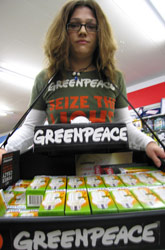 I was just about to write a piece slating Woolworths (as, after all the fuss we caused on Saturday, we still hadn't heard from them) when I got a call from Laura, one of our campaigners, to say she had a letter from them explaining what they're going to do about energy-guzzling light bulbs. I'm looking at it now and I'm sorry, but I'm still going to slate them.
I was just about to write a piece slating Woolworths (as, after all the fuss we caused on Saturday, we still hadn't heard from them) when I got a call from Laura, one of our campaigners, to say she had a letter from them explaining what they're going to do about energy-guzzling light bulbs. I'm looking at it now and I'm sorry, but I'm still going to slate them.
It's from CEO Trevor Bish-Jones who begins by not asking for us not to stage in-store protests in future but to communicate directly with himself. So he'll be pleased about all the emails he's been getting from you (if you haven't emailed him, do it now, or you can call your local branch of Woolies and speak to the manager).
He goes on to use some well-worn arguments which I thought it would be useful to air here. Take it away, Trevor.
"CFL [compact fluorescent lamp] light bulbs are not currently suitable for all uses, e.g. emergency lighting and for vulnerable groups such as the elderly."
I don't know how many bulbs Woolworths sells for use in emergency lighting, but the fact is that efficient CFL bulbs are available for the vast majority of uses. If entire countries like Australia, Cuba and Venezuela can phase out incandescents, there's no reason companies in the UK can't as well. We've exposed more myths like these in the past. And we'd like to see Woolworths' evidence that old people can't use efficient bulbs that save them money.
"We anticipate that consumer demand will change in the next few years and technology will advance. Woolworths will be supportive of this and therefore we expect not to be selling incandescents by 2011."
That word, "expect" - it's nothing like a firm commitment. Instead, it implies that they think customers will probably have stopped wanting to buy incandescents by 2011, but certainly doesn't suggest Woolies are planning anything proactive to stop selling these bulbs. Besides, we're pushing for them to stop selling them by the end of this year. If it takes four or five years to change a light bulb, what hope do we have?
"We have already planned to increase the number of CFL light bulbs we sell. As of the end of September, 23 per cent of our light bulb range will be CFL. It is our understanding that this is well ahead of our competitors."
Hard to see how, given that Currys have already stopped buying new stocks of incandescents in anticipation of phasing them out and in Ikea, sales of CFL bulbs make up 41 per cent of their total bulb sales.
"Again, already planned, is a range of Worthit! (our low price brand) CFL light bulbs... [which] will significantly reduce the price of CFL light bulbs in our stores..."
Will they be cheaper than the current low price of 49p? Mr Bish-Jones doesn't say, but if this new range is included in the 23 per cent mentioned above, that still leaves huge areas of shelving filled with incandscents. Incidentally, all CFLs stocked by Woolworths are supplied by General Electric, the company started by Thomas Edison who is also credited as inventor of the incandescent light bulb. I wrote on Saturday about the historical connections between Edison and Woolworths, so it seems Woolies are putting corporate interests and affiliations ahead of offering customers genuine choice and value.
So, not much in the way of affirmative action from Woolworths. We'll need to reassess the league table to see if they move off the bottom rung but it's not looking good. And speaking of the league table, it's prompted a call from another retailer saying they're going to announce some new policies which they hope will move them up the rankings. I can't say who it is yet, but their sign-off said it all - "We don't want to be Woolworths, do we?"

